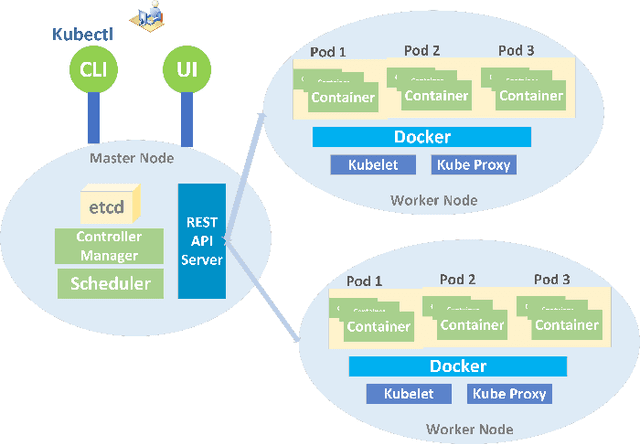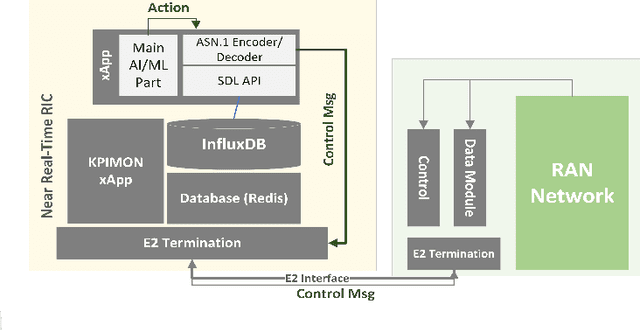Mohammadreza Kouchaki
Federated Neuroevolution O-RAN: Enhancing the Robustness of Deep Reinforcement Learning xApps
Jun 15, 2025Abstract:The open radio access network (O-RAN) architecture introduces RAN intelligent controllers (RICs) to facilitate the management and optimization of the disaggregated RAN. Reinforcement learning (RL) and its advanced form, deep RL (DRL), are increasingly employed for designing intelligent controllers, or xApps, to be deployed in the near-real time (near-RT) RIC. These models often encounter local optima, which raise concerns about their reliability for RAN intelligent control. We therefore introduce Federated O-RAN enabled Neuroevolution (NE)-enhanced DRL (F-ONRL) that deploys an NE-based optimizer xApp in parallel to the RAN controller xApps. This NE-DRL xApp framework enables effective exploration and exploitation in the near-RT RIC without disrupting RAN operations. We implement the NE xApp along with a DRL xApp and deploy them on Open AI Cellular (OAIC) platform and present numerical results that demonstrate the improved robustness of xApps while effectively balancing the additional computational load.
Enhanced Real-Time Threat Detection in 5G Networks: A Self-Attention RNN Autoencoder Approach for Spectral Intrusion Analysis
Nov 05, 2024



Abstract:In the rapidly evolving landscape of 5G technology, safeguarding Radio Frequency (RF) environments against sophisticated intrusions is paramount, especially in dynamic spectrum access and management. This paper presents an enhanced experimental model that integrates a self-attention mechanism with a Recurrent Neural Network (RNN)-based autoencoder for the detection of anomalous spectral activities in 5G networks at the waveform level. Our approach, grounded in time-series analysis, processes in-phase and quadrature (I/Q) samples to identify irregularities that could indicate potential jamming attacks. The model's architecture, augmented with a self-attention layer, extends the capabilities of RNN autoencoders, enabling a more nuanced understanding of temporal dependencies and contextual relationships within the RF spectrum. Utilizing a simulated 5G Radio Access Network (RAN) test-bed constructed with srsRAN 5G and Software Defined Radios (SDRs), we generated a comprehensive stream of data that reflects real-world RF spectrum conditions and attack scenarios. The model is trained to reconstruct standard signal behavior, establishing a normative baseline against which deviations, indicative of security threats, are identified. The proposed architecture is designed to balance between detection precision and computational efficiency, so the LSTM network, enriched with self-attention, continues to optimize for minimal execution latency and power consumption. Conducted on a real-world SDR-based testbed, our results demonstrate the model's improved performance and accuracy in threat detection. Keywords: self-attention, real-time intrusion detection, RNN autoencoder, Transformer architecture, LSTM, time series anomaly detection, 5G Security, spectrum access security.
Actor-Critic Network for O-RAN Resource Allocation: xApp Design, Deployment, and Analysis
Sep 26, 2022



Abstract:Open Radio Access Network (O-RAN) has introduced an emerging RAN architecture that enables openness, intelligence, and automated control. The RAN Intelligent Controller (RIC) provides the platform to design and deploy RAN controllers. xApps are the applications which will take this responsibility by leveraging machine learning (ML) algorithms and acting in near-real time. Despite the opportunities provided by this new architecture, the progress of practical artificial intelligence (AI)-based solutions for network control and automation has been slow. This is mostly because of the lack of an endto-end solution for designing, deploying, and testing AI-based xApps fully executable in real O-RAN network. In this paper we introduce an end-to-end O-RAN design and evaluation procedure and provide a detailed discussion of developing a Reinforcement Learning (RL) based xApp by using two different RL approaches and considering the latest released O-RAN architecture and interfaces.
 Add to Chrome
Add to Chrome Add to Firefox
Add to Firefox Add to Edge
Add to Edge